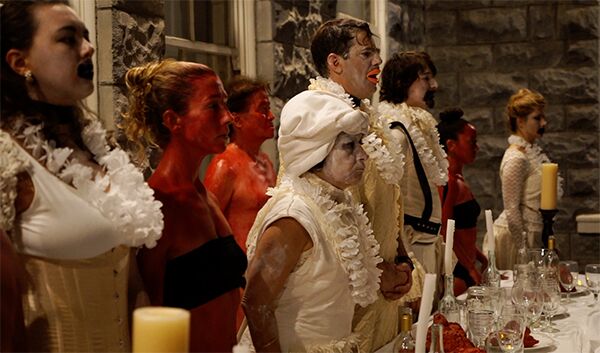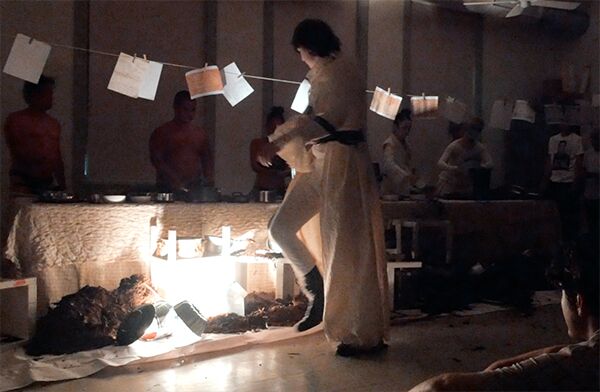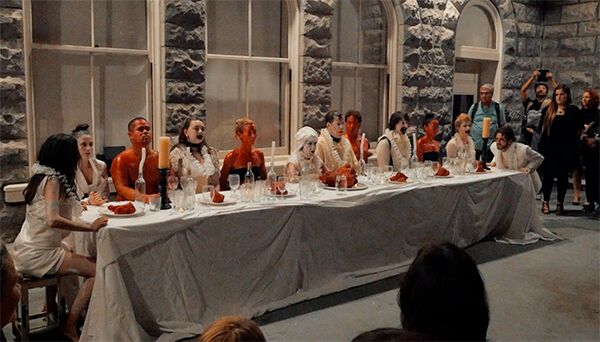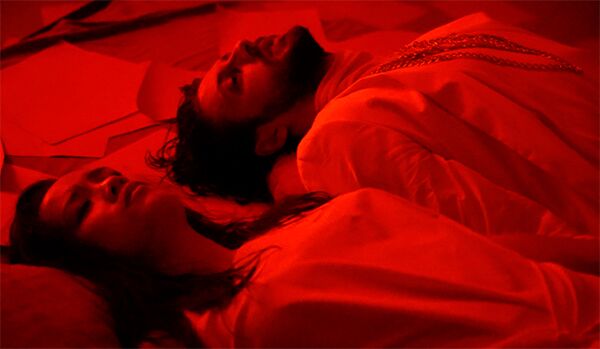Click Here for Part 1. Art Star and painter Masami Teraoka conceived of a collaboration with Russian performance collective Pussy Riot. These words document their performance in Hawaii.
THE NINTH WAVE
The marketing of The Tempest was limited to an events newsletter from the Honolulu Museum of Art. The invitation to the free event caught my eye by chance. The audience on the night of the performance was art-centric, or as the Russian put it, “the art class.” Much later, Viktoria Naraxsa expressed her regret. She had wanted more native Hawai’ians and local people in the audience as she felt she was preaching to the choir. Already, the director was devising plans for her next production in the islands.

On March 17, the day of the show, at 3AM, Viktoria found herself still designing some of the play’s movements. Masha Kechaeva was still creating and crafting costumes from bits, pieces and thrift shop finds. Because of the Academy’s class schedule, the set had to be decorated on the day of the production. Sound. Lights. Electrical. Every city has a rhythm; careful and No Worries works best in Hawai’i, a nightmare for a nervous producer. At the very last minute, an electrician stood up and wired all of the sets. Staggering in the maelstrom, Viktoria “realized how strong I am, and can be.”
THE TEMPEST
As the audience assembled on the front lawn of the Linekona, Viktoria remembers, “looking (out) at the audience to see that it was three times bigger than I had anticipated. I panicked.” In Hawaii, in the air and in the earth, there is an intangible feeling that everything’s gonna be all right. “Masha and I realized we couldn’t do anything about it.”

William Shakespeare wrote the words for Prospero to say, “We are such stuff, as dreams are made, and our little life is rounded with a sleep.” Lucid Dreaming is when the dreamer is aware of dreaming. The audience gathered outside the grand entry of the Linekona. The performance began with a speech, an interactive talk, on the subject led by an actor who played the role with professorial authority. “I think it prepared the audience members for what they were about to encounter with the performance,” explained Lisa Shiroma, “It set them up mentally, so during the performance the audience would think, ‘Whoa. Is this really happening?'”
Behind the audience, on the front lawn of the Linekona, actors, clothed in white, moved slowly, in a Butoh way. Their meditative dance was upset by the arrival of fast moving, violent dancers in red body paint. Masha added, “It was dreamy. That’s why we made a lecture about lucid dreaming before the play. I have this feeling often in my regular life, when I don’t know (if) I am awake or (if) I’m sleeping.”

The audience of more than 150 was divided into two large groups with a choice: To follow Violence or Love? An official led each group and kept order with an authority that would impress Putin.
As one passed through the lanai and entered the century old lobby, audio speakers shook the room with deep bass and yowling reverb. Kyle Kruse composed the potent score for the show. Always a good hand at most anything, the young aesthete also played the role of Ferdinand, coordinated much of the production and transported the Russian talent around the island.
One group was led to the right and the other to the left. “The production had basically taken over the entire building,” said Lisa Shiroma, “Classrooms had been converted with props to represent different elements: air, fire, water and earth. With real dirt!”
Each group experienced two scenes on the ground floor before climbing up to the second for two more. “By having to move from room to room, it made you feel like you were assaulted by scattered and not entirely joined thoughts,” said Cyril Ruthenberg, an award winning photographer, “Sort of like you are trying to go to sleep, but you can’t, because you have all these unpleasant random thoughts pop into your head. Each scene seemed to be directed and performed with the sole purpose of making you thoroughly uncomfortable, but at the same time kept you engaged and prevented you from looking away.”

Between scenes, there was much activity in the darkened hallways. The two groups passed each other like shapeshifting ghost ships. Costumed performers ran to meet their cues. The soundtrack haunted. Had the producers been kind enough to serve hallucinogens and kick up the BPS (Beats Per Second), the evening would have made for a helluva rave.
“It wasn’t the Shakespearean dialog or necessarily the choreography that was so intriguing at The Tempest, it was the all over effect of the actors within the sets, which made the evening so worthwhile,” said Janetta Napp, a once Berlin-based artist who has returned home to Hawaii, “I found the imagery to be like creative paintings, visual elements, leaving a powerful afterimage for later reflection.”
Masami Teraoka was in the audience, trying to document the tidal performance with video. I recall seeing him in the ebb and flow of the crowd, like a ship coursing through rough seas, a video camera lashed to his face. The painter confessed, “I felt I was not able to see all of the performance in the best situation. Often I was standing behind the people.”
Viktoria’s The Tempest is an interaction that could never be properly documented. It had to be experienced. The two audiences observed different performances and narratives. The story was told through movement and imagery. Dialogue was a prop and a sound effect.

THE FLYING VAGINA
One of the beauties of the performance was a stunning video sequence; David Lean would be proud. The audiences converged above the grand staircase in an area reserved for The Tempest Spirits. The video was projected against the wall.
The multi-camera production soared high above the Koko Head Crater to witness its breathtaking, malevolent terrain and stunning views. Said Masha, “We came to Koko Head, early morning before the sunrise, painted our bodies white and started to walk slowly to the top of the crater.” The cast, wearing toga-like vestments, was bound together by a thick red cord. The Shakespeareans lumbered up the 1,050 stairs made of railway ties. (With a laugh and a nod to the popular hiking trail, one shot showed a confused hiker scrambling past the ancient procession.)
“It was a special moment of our journey (to Hawaii),” said Masha, “It was a dedication to the place, as a ritual. The true pure power of the Nature!” And ancient Hawai’ian lore. “If you hear the music of the street, these streets treat you with wonderful gifts. Both (Viktoria and I) paid attention to all these details and they meant a lot to us. That’s how we found ourselves working on a video for the play.” To make a long story short, in another time and realm in Hawai’i, Kapo, the goddess of fertility and sorcery, had to act fast in order to save her sister, popular deity Pele, from the attack of a violent rapist. Quick thinking Kapo threw her detachable vagina and distracted the sex-mad perp. Pele, the Fire Goddess of wind, lightning and volcanoes and creator of the Hawai’ian Islands, was saved. The flying vagina landed on the area that we now know as the Koko Head Crater.

How could this Pussy Riot posse resist incorporating such a tale? Viktoria says, “I was compelled to honor the history of Hawaii and the goddesses. (Hawaii) is a matriarchal place.” Our impresario was also honored by the inclusion. “I love it too,” said Teraoka, “Since the vision included and integrated the earthly environment in Hawaii and Honolulu, I was so touched.”
THE CONJUNCTION
As the video concluded, the two audiences, Violence and Love, moved outside, together as one. The second floor balcony above the lanai of the Linekona is large and semi-circular. The Tempest culminated under a purple night sky, unblemished, for there are very few stars above bright metropolitan Honolulu. The trades were warm and gusting. On Prospero’s Island of Dreams, the tableau was ancient and eternal. A long table, which served a lavish feast of food and drink, was peopled with the entire costumed cast.
The image was sculptural, in shades of marble white and gray. The contrasting color was chunks of cardinal red meat. In the wedding, Miranda married Ferdinand and the spiritual merged with the material.
Down below on the front lawn, the former antagonist Caliban raised a white flag to the top of the mast and tied it off. The symbol of truce and restored harmony snapped in the trade winds. “Dreams and reality are not different,” said Viktoria with a smile, “Humans need for one another.”

FLOTSAM AND JETSAM
The success of the production awarded no rest for the weary. With classes the next morning, the Linekona needed to be undressed, cleaned up and restored.
There was a flood in one room. Ferdinand’s nude matrimonial bath got frisky and splashy. A window was broken when an actor’s head was knocked into the glass. The dramatic fight scene had been well rehearsed for drama and safety. “During rehearsals, I kept calling for more realism when Alonzo is attacked,” said Viktoria. Fortunately, Alonzo shed no blood and survived the ordeal.
Forgiveness was hoped for. And granted. Vince Hazen, the Director of the Honolulu Museum of Art School, replied, “To make art, you have to take risks. The Tempest was a great success.”
With a case of beer and a toast of vodka, the clean up served as a glamorous and utilitarian after party for the exhausted volunteers, performers and supporters. That’s show biz. A day later, the group rejoined for a potluck, at sunset, on the beach.
The Russians had a hard time leaving Hawaii. Masha dragged her bag to the airport and flew west to Moscow. The siren call of the Pacific resounded loudly with the director; Viktoria stayed an extra two weeks. In that time, her skin grew tan and dark. She learned to surf in the near perfect waves of Waikiki.
The Sport of Kings intoxicates many and Viktoria was besotted. Actor Steve de Mesa was a devoted member of The Tempest crew. Like all of the volunteers, he had to balance the hectic production schedule with his busy job in real estate at Luxury Homes International. Steve took Viktoria out on his nine-foot Chronic longboard for a lesson. He recalls, “She approached surfing like her acting and direction. Very courageous. She is young, beautiful and has a strong physicality. She’s amazing.”
Viktoria surfed everyday, until the light of day or her tired body called it quits. On one occasion, an interview with Masami Teraoka and Noe Tanigawa of Hawai’i Public Radio kept her from the blue Pacific.

MANA
Hawaii is one of the newest lands on this earth. The life cycle is aggressive and readily apparent. The smell of raw, red earth and lush plant life is everywhere. Everything is blooming and decaying. Growing and dying are one in the same.
At the Moana Surfrider, under the Banyan tree, I had to ask Viktoria, “What has Hawaii, this incredible place, meant to you?” She lit up and spoke rapidly with great passion. Her Russian speech flowed and danced. Her hands sailed with expression. I did not understand the words but I knew the meaning, the intent and the heart. I believed she was speaking of the passionate smell of the plumeria, the sigh of water rushing across sand and the wind that touches your skin like a lover. The waitress slammed in, so I ordered another beer in order to send her quickly away. Viktoria continued in her native tongue, the lilting phrase, the dancing rhymes and the stubbed toe of smashing consonants.
As she was speaking, I noticed two dots, captivating twins, each above an eye, just below the eyebrow. Birthmarks? Symbols of a saint? Freckles of a goddess?
Her thoughts on Hawaii and its impact upon her sensibilities flowed forth with affection, excitement and joy. Exhausted by her lengthy response, Viktoria sat back in her chair. The translator, reading from her notes, took over, “Hawaii is a harmonious environment. Everything is right and makes sense. The energy. I am so glad Shakespeare’s play tied into local history.” Only a poet can truly speak for a poet.
Later, when queried, Viktoria said that mystical, magical things had happened to her upon the trip, stories that she cannot tell. I asked about the beauty marks above her eyes. The edges of her lips lifted in a sly smile as she answered, “Magic art.” I had to laugh with her, for is not all art magic?
Later, back in Moscow, Masha would expound upon the Hawaiian relevance, “When I describe my experience at Oahu to my friends, I start with the experience of nature there. And the way people connect to it. It’s unique. It’s an open dialogue between them, plus (a) re-invention of old Hawaiian traditions and reinterpretation of them in the modern world. It’s (a) very organic mix. It’s still there, and I’m happy about that.”

BURNING EMBERS
“Like Pussy Riot, Masami is a rebel in his own right. He believes his art can serve as a platform for voicing dissension,” said Catharine Clark, his gallerist of 20 years. “He is not afraid of confrontation or to stand up with his paintbrush for the human values and individual rights he feels are violated by government, religious or any other institution of power. I believe the Hawai’i performance is a parallel exploration through a different medium that is the embodiment of the ideas and ethics voiced in his own work.”
The 2012 Pussy Riot performance and arrest were shocking and disturbing to many in the worldwide arts community. As an American artist, my naiveté of persecution was reserved to a National Endowment of the Arts kerfuffle or a red-faced mayor with a confusing new sculpture in his town square. The fate of Pussy Riot redefined and grounded my concept of oppression. The torture was real.
While Pussy Riot’s Nadya Tolokonnikova and Maria Alyokhina were suffering in prison, a defiant protest graphic began to appear in Russia. The taciturn visage of Vladimir Putin is decorated with cartoonish drag queen make-up, an unbecoming statement to a thin-skinned dictator. This blasphemy of portraiture has never gone away. Worse, the cartoon became a brave and popular t-shirt design. As I write these words, an august TV newscaster on a major American network is freely stating that the 45th President of the United States is a “Cheetos-colored Fascist he-man woman-hater.” Conversely, the UK Telegraph has reported that the “extremist” image of Putin in candy colored eye shadow and glossy lipstick is now legally recognized as “banned material” in Russia. The bumper sticker will get you tossed in the gulag.
Now that this Tempest documentation is complete, I think I’ll put my feet up and relax with a Putini, a cocktail archly mixed with Pussy Riot Vodka and a whiff of Lillet. I suddenly appreciate how lucky I am to be an artist in America, where persecution is more perceived than realized.
Gordy Grundy is a Pacific-based artist. His visual and literary work can be found at www.GordyGrundy.com


